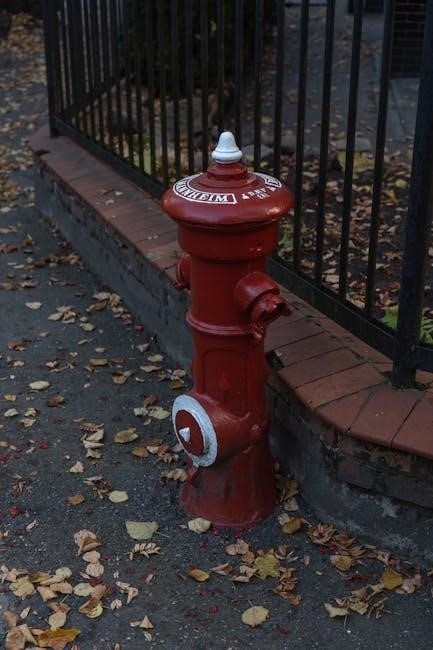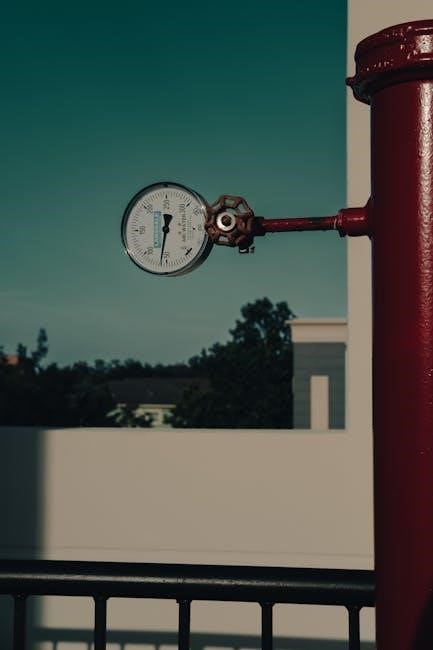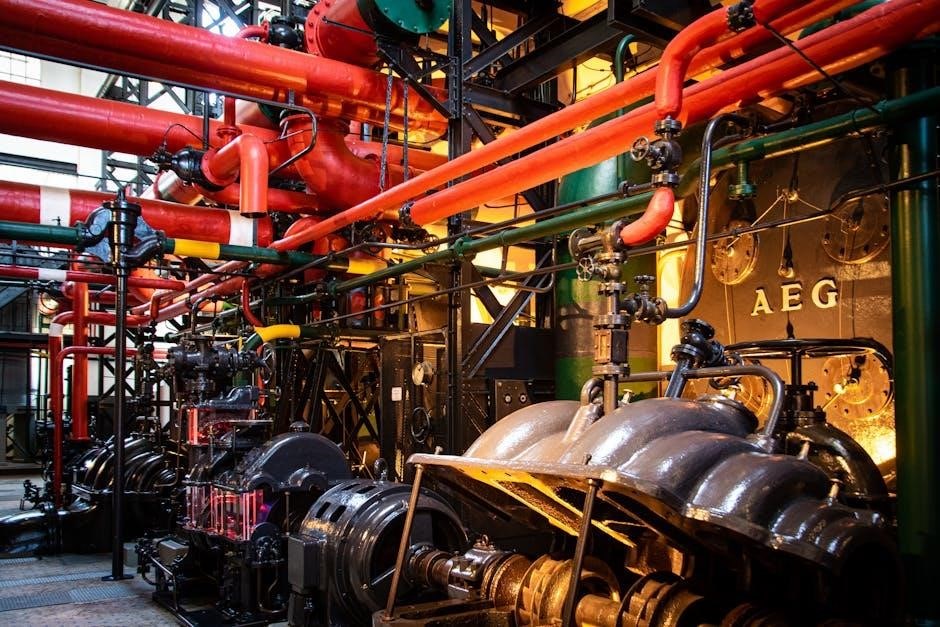Knurling valve guides is a precise engineering process that restores proper clearance and function to worn valve guides, enhancing engine performance and reducing oil leakage effectively.
What is Knurling?
Knurling is a mechanical process that creates a textured surface on metal parts, such as valve guides. It involves using a specialized tool to imprint a pattern of ridges or grooves on the surface. This process is used to restore worn surfaces, improve fitment, and control oil leakage by adjusting clearances. The tool is inserted into the guide bore and, when rotated, reshapes the metal to create the desired texture without removing material. Knurling is particularly effective for reconditioning valve guides in engines, helping to maintain proper valve alignment and performance.
The Role of Valve Guides in Engines
Valve guides play a critical role in engines by maintaining proper valve alignment and clearance. They ensure precise movement of the valve stem, preventing excessive wear and oil leakage. Guides help position the valve centrally, minimizing lateral movement and ensuring efficient combustion chamber sealing. Their integrity directly impacts engine performance, oil consumption, and overall durability, making them essential for optimal engine operation and longevity.

Why Knurling is Used for Valve Guides
Knurling is used to restore worn valve guides by creating a precise surface texture, ensuring proper valve stem alignment and reducing oil leakage for improved engine efficiency.
Clearance Adjustment in Valve Guides
Knurling adjusts valve guide clearance by raising metal on the guide’s inner surface, ensuring the valve stem operates smoothly within the desired tolerance. This process minimizes wear and reduces oil leakage, thereby improving engine performance and longevity. Proper clearance is critical for efficient combustion and power delivery, making knurling a vital maintenance technique for engine longevity.
Reducing Oil Loss and Improving Performance
Knurling valve guides effectively minimizes oil leakage by restoring the guide’s surface integrity, ensuring the valve stem fits snugly. This tight fit prevents oil from bypassing the guide, reducing consumption and enhancing combustion efficiency. Improved valve alignment and reduced wear contribute to better engine performance, higher power output, and lower emissions, making knurling a cost-effective solution for engine maintenance and optimization.
Tools and Equipment for Knurling Valve Guides
Specialized tools, like UTP knurling tools, are essential for valve guide maintenance. They effectively resize and create precise knurling patterns, ensuring a snug fit and minimal material removal.
Knurling Tools and Their Functionality
Knurling tools are specially designed to create precise textured patterns on valve guides, restoring proper clearances. UTP tools are highly effective, allowing visible metal movement and eliminating ghost patterns during operation. These tools ensure accurate resizing and surface finish, critical for optimal engine performance and minimizing oil leakage. Their functionality is essential for achieving the desired fit and longevity of valve guides in various engine types.
UTP Knurling Tools: Features and Benefits
UTP knurling tools are renowned for their ability to precisely recondition valve guides. They feature adjustable cutting depths and diamond-coated rollers, ensuring efficient metal removal. Their design allows for real-time monitoring of the knurling process, enabling immediate adjustments. These tools minimize material waste and offer a cost-effective solution, making them a preferred choice for engine rebuilders seeking high-precision and durability in valve guide restoration.

The Knurling Process
The knurling process involves using specialized tools to create a textured surface on valve guides, restoring proper clearance and enhancing durability. It ensures precise alignment and reduces wear, improving engine performance and longevity effectively.
Step-by-Step Guide to Knurling Valve Guides
Begin by inspecting the valve guide bore for wear or damage. Insert the knurling tool into the guide, ensuring proper alignment. Rotate the tool while advancing it slowly to create the knurled pattern. Monitor progress to avoid over-knurling. Once complete, remove the tool and inspect the area for even texture and restored clearance. This process ensures optimal valve stem fitment and performance.
Inspecting and Preparing the Valve Guide Bore
Inspect the valve guide bore for wear, scoring, or excessive clearance. Clean the area thoroughly to remove debris. Measure the bore diameter to ensure it meets specifications. If damaged, repair or resize the bore before knurling. Apply a light coating of lubricant to the tool and guide surface. Proper preparation ensures a smooth, even knurling process and optimal results.
Pros and Cons of Knurling Valve Guides
Knurling valve guides offers cost-effective restoration of worn guides, improving engine performance and reducing oil leakage. However, it requires precise skill and isn’t suitable for severely damaged guides.
Advantages of Knurling
Knurling valve guides is a cost-effective method to restore worn guides, reducing oil leakage and improving valve stem stability. It enhances engine performance by maintaining proper clearance, extends guide life, and is a precise, efficient solution for engine maintenance without requiring replacement parts. This technique is particularly beneficial for reconditioning engines, offering a practical alternative to costly replacements while ensuring optimal functionality and durability.
Limitations and Potential Risks
Knurling valve guides may not be suitable for all materials, such as bronze guides, due to potential damage risks. Over-knurling can lead to excessive stress, causing guide failure. Improper tool alignment or excessive force may result in bore damage or uneven surfaces. Additionally, knurling requires skilled technicians to avoid complications, making it less accessible for inexperienced users. These risks highlight the need for precision and expertise in the process.

Materials Used in Valve Guides
Valve guides are often made from durable materials like bronze or cast iron, chosen for their strength and heat resistance. These materials support the knurling process effectively, ensuring longevity and optimal engine performance while withstanding high-temperature environments. The choice of material is critical for maintaining proper valve stem clearance and preventing wear over time.
Bronze Valve Guides: Knurling Considerations
Bronze valve guides are highly durable and resistant to wear, making them ideal for knurling. However, their hardness requires specialized tools to avoid damage. The knurling process on bronze guides must be precise to maintain proper clearance and prevent oil leakage. While bronze can be knurled successfully, it demands careful tool selection and technique to ensure effective results without compromising the material’s integrity or performance over time.
Cast Iron Valve Guides: Knurling Techniques
Cast iron valve guides are softer than bronze, making knurling more straightforward. Techniques involve using a knurling tool to create micro-serrations, which adjust clearance and reduce oil seepage. The process requires controlled pressure to avoid cracking the cast iron while ensuring proper alignment; This method is effective for reconditioning worn guides without replacement, enhancing engine efficiency and extending component lifespan significantly through precise application of the knurling tool.
Common Mistakes in Knurling Valve Guides
Improper tool alignment, excessive force, and insufficient lubrication are frequent errors that can damage guides or tools, highlighting the need for precision and care in execution.
Incorrect Tool Alignment and Usage
Misaligning the knurling tool can lead to uneven grooves, reducing the effectiveness of the repair and potentially causing further damage to the valve guide or engine head. Proper alignment ensures consistent pressure and avoids tool slippage, which can scratch the bore or create excessive stress points, compromising the integrity of the valve guide structure over time.
Over-Knurling and Its Consequences
Over-knurling exceeds the desired clearance adjustment, potentially causing excessive metal removal and weakening the valve guide. This can lead to reduced structural integrity, increased oil leakage, and improper valve alignment. It may necessitate costly repairs, such as replacing the guide, to restore engine performance and prevent further damage to surrounding components.

Best Practices for Knurling Valve Guides
Use proper lubrication, maintain precise tool alignment, and monitor progress to avoid over-knurling. Ensure the guide bore is clean and dry for optimal results.
Ensuring Proper Tool Lubrication
Proper tool lubrication is critical during knurling to prevent overheating and ensure smooth operation. Use a high-performance cutting oil to reduce friction and wear on the knurling tool. Apply lubricant directly to the tool and guide bore before starting the process. Regularly reapply lubrication as needed to maintain optimal conditions and achieve precise, consistent results without damaging the tool or valve guide.
Monitoring the Knurling Process
Continuous monitoring of the knurling process ensures accuracy and prevents over knurling. Use visual inspection and tactile feedback to assess progress. Check the guide bore frequently with a micrometer to maintain desired dimensions. Listen for changes in tool operation sounds, as unusual noises may indicate issues. Stop immediately if irregularities occur to avoid damage to the valve guide or tool.
Applications of Knurling in Engine Maintenance
Knurling is vital for restoring valve guide clearance, reducing oil leakage, and enhancing engine performance, making it a key technique in various engine maintenance and repair scenarios.
High-Performance Engines
In high-performance engines, knurling valve guides is a critical process to restore precise valve stem clearance, ensuring optimal engine efficiency and performance. This technique is particularly beneficial in racing and high-stress applications, where maintaining exact tolerances is crucial. By reducing oil consumption and improving valve train stability, knurling extends the lifespan of engine components, making it a cost-effective and reliable solution for enthusiasts seeking peak performance without compromising durability.
The ability to maintain precise clearances without replacing guides makes knurling especially suitable for high-performance engines, where every detail matters for achieving maximum power and efficiency. This method ensures that the valve operates smoothly, reducing wear and tear, and is often preferred in applications where engine reliability is paramount.
Overall, knurling is a valuable technique for enhancing the performance and longevity of high-performance engines, offering a practical approach to maintaining optimal engine function under extreme conditions.
Classic and Vintage Engines
Knurling valve guides is a popular reconditioning method for classic and vintage engines, offering a cost-effective way to restore original performance without replacing rare or hard-to-find components. This technique preserves the engine’s authenticity while addressing wear and tear, making it a preferred choice among restorers. By maintaining precise clearances, knurling ensures smooth operation and minimizes oil leakage, extending the life of these timeless engines.
In vintage engines, where original parts are often irreplaceable, knurling provides a practical solution to common issues like excessive valve stem clearance. This method allows enthusiasts to retain the engine’s original character while improving its reliability and performance.
Overall, knurling is a valuable technique for classic and vintage engines, blending preservation with modern engineering to keep these iconic powerplants running smoothly for years to come.
Case Studies and Real-World Examples
A classic engine restoration project successfully used knurling to repair worn valve guides, eliminating oil leakage and restoring proper valve alignment, ensuring reliable performance and longevity.
Before-and-After Results of Knurling
Knurling significantly improves valve guide performance. Before knurling, worn guides often lead to excessive clearance, oil leakage, and reduced engine efficiency. After knurling, the guide bore is restored, clearance is adjusted, and oil consumption is minimized. This process ensures proper valve stem alignment, enhancing overall engine performance and longevity, as demonstrated in successful classic engine restorations and high-performance applications.
Success Stories in Engine Reconditioning
Knurling valve guides has proven successful in various engine restorations. A classic vintage V8 engine experienced reduced oil leakage and improved performance post-knurling; High-performance racing engines also benefited, with enhanced valve alignment and reduced wear. UTP knurling tools were pivotal in these successes, demonstrating the technique’s effectiveness in extending engine life and maintaining peak performance across diverse applications.

Safety Considerations
Proper handling of knurling tools is crucial. Always wear protective gear and ensure a stable workspace to prevent accidents during the knurling process.
Handling Knurling Tools Safely
Safe handling of knurling tools is essential to prevent injuries. Always wear protective gloves, safety glasses, and ensure the workspace is clear. Proper tool alignment and controlled rotation prevent accidents. Never apply excessive force, as this can lead to tool slippage. Regularly inspect tools for wear and maintain them according to manufacturer guidelines to ensure reliability during the process.
Protective Gear and Workspace Setup
Setting up a safe workspace and using proper protective gear is crucial when knurling valve guides. Wear safety glasses, gloves, and a face mask to protect against metal debris. Ensure the work area is well-lit, clean, and free from obstacles. Secure the engine block firmly to prevent movement during the process. Keep tools organized and within reach to maintain focus and efficiency.
Comparison with Alternative Methods
Knurling valve guides is often compared to replacing or reconditioning methods, offering a cost-effective solution with minimal downtime, ideal for restoring worn guides without complete replacement.
Knurling vs. Replacing Valve Guides
Knurling valve guides is a cost-effective alternative to replacement, offering a quicker process with minimal downtime. It restores functionality by adjusting clearances, reducing oil leakage, and improving valve stem stability. Unlike replacement, knurling preserves the original guide, making it ideal for engines where replacing guides would be time-consuming or expensive. This method is particularly favored in high-performance and vintage engines where maintaining originality is crucial. Additionally, knurling tools allow for precise adjustments, ensuring optimal performance without the need for new parts. However, knurling may not be suitable for severely damaged guides, where replacement remains the best option. Overall, knurling provides a practical solution for minor wear, extending guide life efficiently.
Knurling vs. Other Reconditioning Techniques
Knurling stands out among reconditioning methods for its ability to precisely adjust valve guide clearances without removing material. Unlike sleeve installation or machining, knurling is less invasive, preserving the original guide structure. It offers a cost-effective solution compared to replacement, with faster turnaround times. However, knurling’s suitability depends on the extent of wear, making it ideal for minor damage. Other techniques, like sleeving, are better for severely damaged guides, but knurling remains a preferred choice for maintaining original engine components with minimal downtime, ensuring optimal performance and longevity.

Cost Implications
Knurling valve guides is a cost-effective method compared to replacing guides, reducing labor and material expenses. It extends guide life, offering long-term financial benefits.
Cost-Effectiveness of Knurling
Knurling valve guides is an economical alternative to guide replacement, minimizing costs while restoring functionality. It extends the service life of components and reduces downtime. The process is particularly cost-effective for engines with otherwise reusable parts. UTP knurling tools further enhance efficiency, making it a budget-friendly solution for both classic and high-performance engines. This method is widely regarded as a financially viable option for engine maintenance.
Long-Term Savings and Benefits
Knurling valve guides offers significant long-term savings by reducing the need for frequent replacements and minimizing oil consumption. This process extends engine lifespan, lowers maintenance costs, and improves overall performance. By restoring proper valve alignment and clearance, it prevents premature wear on other components, ensuring a more reliable and efficient engine operation over time. These benefits make knurling a valuable investment for engine longevity.

Maintenance After Knurling
Regular inspections are essential to ensure valve guides remain functional after knurling. Check valve stem clearance periodically to maintain proper specifications. Keep the area clean and well-lubricated to prevent wear. Following these steps ensures optimal engine performance and extends the lifespan of the valve guides.
Post-Knurling Care for Valve Guides
After knurling, clean the valve guide bore thoroughly to remove debris. Apply a thin layer of engine oil to the knurled area for lubrication. Regularly inspect the valve stem and guide clearance to ensure proper alignment and functionality. Address any signs of wear or misalignment promptly to maintain optimal engine performance and prevent future issues. Proper care extends the lifespan of the knurled valve guides.
Regular Inspection and Adjustment
Schedule periodic inspections of knurled valve guides to monitor wear and clearance. Use precision tools to measure stem-to-guide clearance, ensuring it remains within manufacturer specifications. Adjustments may involve minor re-knurling or lubrication. Consistent monitoring prevents excessive wear, maintains proper valve alignment, and ensures efficient engine operation. Early detection of issues avoids costly repairs and extends the service life of the engine components.
Future Trends in Valve Guide Knurling
Advancements in tool technology and materials promise improved precision and durability. Emerging techniques may incorporate automation and eco-friendly practices to enhance knurling efficiency and engine performance.
Advancements in Tool Technology
Innovations in knurling tools are revolutionizing the process, with adjustable depth control and self-centering features now available. Modern tools utilize advanced materials for durability and precision, reducing wear on valve guides. Smart tools with sensors provide real-time feedback, enhancing accuracy and efficiency. These advancements aim to streamline the knurling process while maintaining high-quality results, making it more accessible for both professionals and enthusiasts.
Modern Materials and Techniques
Modern materials like advanced bronze alloys and coated valve guides are improving durability and performance. Techniques such as laser-guided alignment and CNC-controlled knurling enhance precision, reducing human error. These innovations ensure consistent results, extend engine lifespan, and lower maintenance costs, making knurling a sustainable solution for engine reconditioning in both classic and high-performance vehicles.
Knurling valve guides is a cost-effective method to restore engine efficiency, reduce oil loss, and extend valve life. It’s a valuable technique for engine enthusiasts seeking reliable performance and durability.
Final Thoughts on Knurling Valve Guides
Knurling valve guides is a practical solution for restoring engine performance and reducing oil leakage. It offers a cost-effective alternative to replacing guides. With proper tools and techniques, knurling ensures precision and durability, making it a recommended method for engine enthusiasts and technicians aiming to maintain optimal engine function and longevity effectively.
Recommendations for Engine Enthusiasts
Engine enthusiasts should consider knurling as a viable method for restoring valve guides. It is cost-effective and preserves the original engine components. Proper training and quality tools are essential for successful outcomes. Regular inspections and adherence to best practices ensure longevity and optimal engine performance, making knurling a valuable skill for maintaining classic and high-performance engines effectively.
